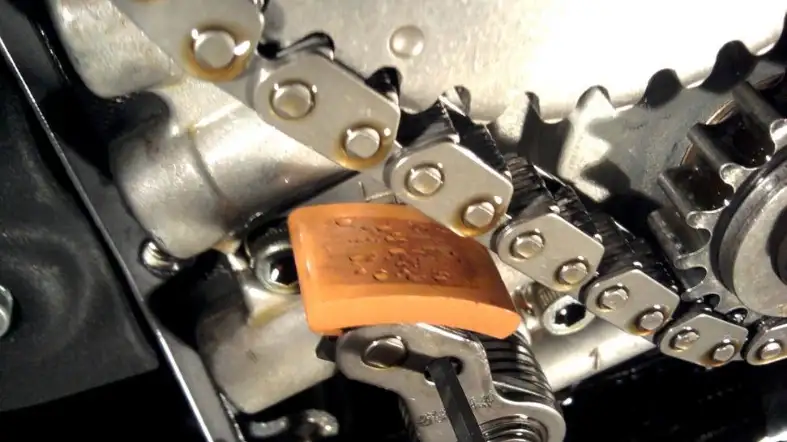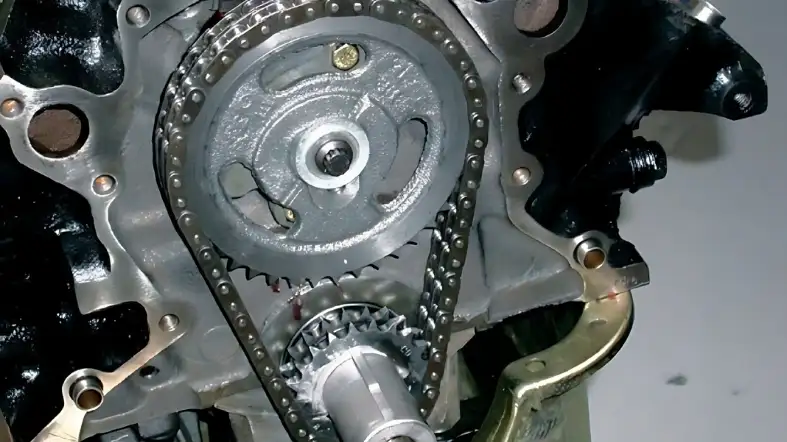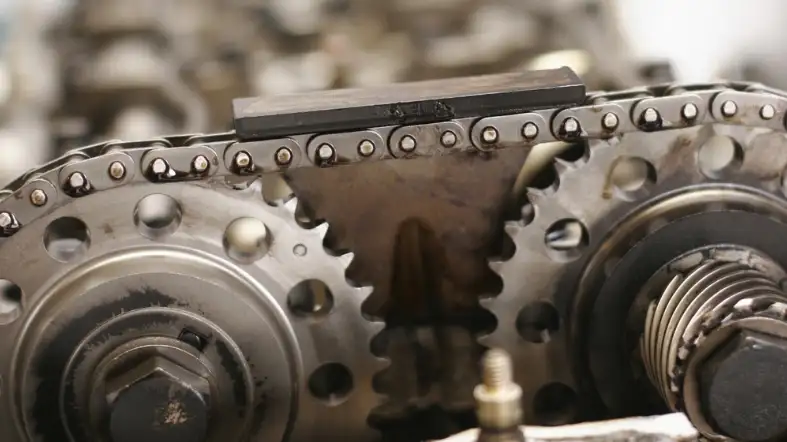Are you a proud owner of a Harley-Davidson motorcycle? If so, you know that proper maintenance is key to keeping your ride in top condition.
One of the most critical components of your bike’s engine is the cam chain tensioner, which helps ensure that the timing of the camshaft is just right.
Unfortunately, over time, this crucial part can start to wear down and cause serious problems.
In this blog post, we’ll explore how to tell if your cam chain tensioner is bad and what you can do to fix it.
How to tell if cam chain tensioner is bad harley?
A cam chain tensioner is an important component of Harley’s engine that ensures the cam chain stays tight and doesn’t slip or skip.

Over time, the tensioner can wear out or become faulty. It can cause issues with your bike’s performance.
Here are some signs that your Harley’s cam chain tensioner might be bad:
1. Unusual engine noises:
One of the most common indicators of a bad cam chain tensioner is the presence of rattling or knocking noises emanating from the engine.
When the tensioner fails to keep the cam chain adequately taut, it can result in the chain slapping against other engine components.
This contact generates the unusual noises that you may hear.
2. Poor performance:
A faulty cam chain tensioner can adversely affect the performance of your Harley.
You might notice a lack of power or acceleration while riding.
The engine may also feel rough or sluggish, failing to deliver the smooth and responsive performance you are accustomed to.
These symptoms can be attributed to the improper functioning of the cam chain tensioner.
3. Check engine light:
If the cam chain tensioner is not operating correctly, it can trigger the activation of the check engine light on your Harley’s dashboard.
The tensioner is responsible for maintaining precise timing in the engine.
When it malfunctions, it can disrupt the engine’s timing, leading to the illumination of the check engine light.
This serves as an important warning sign that the cam chain tensioner requires attention.
4. Oil leaks:
Typically positioned near the engine’s oil system, a faulty cam chain tensioner can contribute to oil leaks.
The tensioner’s failure can disrupt the proper sealing of the engine, resulting in oil seeping out.
Not only can oil leaks create a messy appearance, but they can also pose a potential hazard if the oil drips onto hot engine parts.
Therefore, if you notice oil stains or puddles beneath your Harley, it could be an indication of a bad cam chain tensioner.
5. Visible wear:
To further assess the condition of your cam chain tensioner, you can conduct a physical inspection.
Look closely for any signs of wear or damage on the tensioner itself or the cam chain.
Examine the tensioner for cracks, breakages, or other visible indications of deterioration.
Similarly, inspect the cam chain for any wear, such as elongation or visible damage.
Visual evidence of wear can provide valuable insights into the state of your Harley’s cam chain tensioner.
What are the causes of a Bad Cam Chain Tensioner?

A bad cam chain tensioner can cause a variety of problems in your engine, including poor performance, increased wear and tear on engine components, and even engine failure.
Here are some of the common causes of a bad cam chain tensioner:
1. Wear and Tear:
One of the primary causes of a bad cam chain tensioner is regular wear and tear.
Over time, the tensioner can experience mechanical stress and strain, leading to its deterioration.
The constant movement and pressure can wear down the components, causing the tensioner to malfunction and fail in its primary task of keeping the cam chain properly tensioned.
It is crucial to monitor the condition of the tensioner regularly and replace it when signs of wear become noticeable.
2. Lack of Maintenance:
Regular maintenance plays a vital role in the longevity and performance of your engine.
Neglecting maintenance tasks, such as checking and replacing the cam chain tensioner when necessary, can result in its degradation over time.
Without proper care and timely replacement, the tensioner may become damaged or ineffective, affecting the overall performance and reliability of your engine.
Be sure to follow the manufacturer’s recommended maintenance schedule and replace the tensioner as advised.
3. Dirty or Contaminated Oil:
Clean and fresh oil is crucial for the proper functioning of the cam chain tensioner.
When the oil becomes dirty or contaminated with debris, it can hinder the smooth operation of the tensioner.
Over time, the presence of dirt, particles, or sludge in the oil can cause the tensioner to become stuck or damaged, leading to inadequate tension on the cam chain.
Regularly changing the oil and using a high-quality oil filter can help prevent this issue and maintain the optimal performance of the cam chain tensioner.
4. Incorrect Installation:
Proper installation is key to ensuring the cam chain tensioner functions correctly.
If the tensioner is not installed according to the manufacturer’s instructions, it can disrupt the engine’s timing and performance.
Incorrect installation may lead to inadequate tension on the cam chain or misalignment of the components, causing issues such as noise, reduced power, or even engine damage.
Always carefully follow the installation guidelines provided by the manufacturer to avoid such problems and ensure optimal performance.
5. Defective Parts:
In rare cases, the cam chain tensioner itself may be defective or contain faulty parts.
Manufacturing defects or substandard materials can compromise the tensioner’s functionality, leading to premature failure or inadequate performance.
If you notice persistent issues with the cam chain tensioner despite proper installation and maintenance, it is advisable to consult with a professional mechanic or contact the manufacturer.
How to prevent a Cam Chain Tensioner from future damage?

Here are some tips to prevent your cam chain tensioner from going bad:
1. Regular Maintenance:
To ensure that your cam chain tensioner remains in good condition, it is crucial to get your car serviced regularly.
During these maintenance appointments, professionals will check and adjust the components, including the cam chain tensioner, to ensure they are functioning correctly.
Additionally, regular oil changes and replacing worn-out parts will help prevent problems in the long run.
2. Keep the Engine Clean:
Dirt and debris can accumulate in the engine over time, potentially causing problems with the cam chain tensioner.
It is important to keep the engine clean by regularly wiping down the exterior surfaces and removing any debris that might have settled.
Be cautious when cleaning to avoid getting water or cleaning agents into the engine itself, as this can cause damage.
3. Use High-Quality Oil:
The quality of the oil you use in your engine plays a significant role in keeping it running smoothly and reducing wear and tear on the cam chain tensioner.
It is essential to use high-quality oil that meets the manufacturer’s specifications.
Check your vehicle’s manual or consult with a professional to determine the recommended oil viscosity for your specific vehicle.
Additionally, make sure to change the oil at regular intervals as per the manufacturer’s recommendations.
4. Avoid Overloading the Engine:
Overloading the engine can put unnecessary stress on the cam chain tensioner, potentially leading to problems and damage.
It is important to ensure that you do not exceed the maximum weight limit recommended for your vehicle.
If you are towing, make sure not to exceed the recommended weight limit for towing.
By avoiding overloading, you can help preserve the lifespan of the cam chain tensioner and other engine components.
5. Listen for Strange Noises:
Listening for any unusual or strange noises coming from the engine is crucial.
Strange noises can be an early indication that something is wrong with the cam chain tensioner or other engine components.
If you hear any grinding, rattling, or knocking sounds, it is essential to get your vehicle checked out by a qualified mechanic as soon as possible.
Prompt attention to these noises can help diagnose and address any potential issues before they escalate.
6. Avoid Abrupt Changes in RPM:
Abrupt changes in RPM (revolutions per minute) can cause stress on the cam chain tensioner, potentially leading to damage.
It is important to avoid harsh acceleration or deceleration whenever possible. Instead, try to maintain a smooth and steady driving style.
Gradual changes in RPM allow the cam chain tensioner to adjust more smoothly, reducing the risk of damage.
By practicing a more controlled driving approach, you can help prolong the life of your cam chain tensioner and promote its optimal functioning.
How to maintain a Cam Chain Tensioner?

Here are some tips on how to maintain your cam chain tensioner:
1. Regular Inspection:
To ensure the optimal functioning of your cam chain tensioner, it is important to regularly inspect it for any signs of wear or damage.
Look for cracks, chips, or any other visible indications of wear on the tensioner body.
Additionally, check the mounting bolts to ensure they are securely fastened.
If you notice any significant wear or damage, it is crucial to replace the tensioner promptly to prevent further engine damage.
2. Lubrication:
Proper lubrication is essential for the effective operation of the cam chain tensioner.
It is important to ensure that there is sufficient oil flow to the tensioner and that the oil is clean.
Regularly check the oil level in your engine and change it according to the manufacturer’s recommended intervals.
Dirty or contaminated oil can hinder the performance of the tensioner and lead to premature wear.
Make sure to use the recommended type of oil for your engine and follow the manufacturer’s guidelines for oil changes.
3. Tension Adjustment:
If you notice that the cam chain is loose or making abnormal noises, it may be necessary to adjust the tension on the tensioner.
Refer to the manufacturer’s instructions or service manual for the specific steps to adjust the tension.
Typically, this involves loosening the locking nut or bolt and turning the tensioner adjustment screw to achieve the desired chain tension.
Be cautious not to overtighten the chain, as it can lead to excessive wear or premature failure.
Once the tension is adjusted, secure the locking nut or bolt to prevent any unintended changes.
4. Replacement:
Over time, the cam chain tensioner may become worn or damaged, and it is important to replace it when necessary.
If you observe persistent issues with chain tension or if the tensioner is excessively worn or damaged, it is recommended to replace it with a new one.
Consult the manufacturer’s specifications or consult a professional mechanic to ensure you select the correct replacement part for your engine model.
5. Cleanliness:
Maintaining cleanliness around the cam chain tensioner is crucial to prevent the accumulation of dirt, debris, or other contaminants that may clog the oil passages.
Regularly inspect the area surrounding the tensioner for any accumulation of grime, mud, or foreign particles.
If you notice any buildup, carefully clean the area using a soft brush or cloth. Be cautious not to let any debris fall into the engine during the cleaning process.
Keeping the tensioner and its surroundings clean will help ensure optimal oil flow and prevent potential issues.
6. Professional Inspection:
If you are uncertain about how to properly maintain your cam chain tensioner, or if you notice any unusual problems with your engine, it is always advisable to consult a professional mechanic.
They have the expertise and experience to diagnose the issue accurately and provide the necessary repairs or maintenance.
Seeking professional assistance can help prevent further damage and ensure the long-term performance and reliability of your engine.
FAQs
Q. What Is A Cam Chain Tensioner, And What Does It Do?
A: A cam chain tensioner is a component in your Harley’s engine that helps maintain the proper tension on the timing chain, which controls the opening and closing of the engine’s valves.
The tensioner ensures that the timing chain stays in place and doesn’t jump off the sprockets, which can cause major engine damage.
Q. Can A Bad Cam Chain Tensioner Cause Engine Damage?
A: Yes, a bad cam chain tensioner can potentially cause serious engine damage if it’s not addressed quickly.
If the timing chain jumps off the sprockets or skips a tooth, the engine’s valves can collide with the pistons, causing major internal damage.
Q. How Often Should I Have My Cam Chain Tensioner Inspected/Replaced?
A: The frequency with which you should have your cam chain tensioner inspected/replaced can vary depending on factors like your riding style, mileage, and the age of your bike.
However, most Harley mechanics recommend having the tensioner inspected every 25,000 miles and replaced every 50,000-75,000 miles as a preventative measure.
If you notice any of the signs of a bad cam chain tensioner mentioned above, you should have it checked out right away regardless of your mileage.
Conclusion
If you can prevent Harley’s cam chain tensioner from being bad it can increase your bike’s health and avoid potential engine damage.
To prevent this, check it there are any symptoms like loud ticking sounds, poor engine performance, and oil leaks.
Regularly inspecting and replacing the cam chain tensioner can save you a lot of trouble and keep your Harley running smoothly.
If you don’t know about the condition of your tensioner, don’t hesitate to seek professional help from a certified mechanic.
Taking care of your Harley is essential for enjoying many miles of smooth riding!
